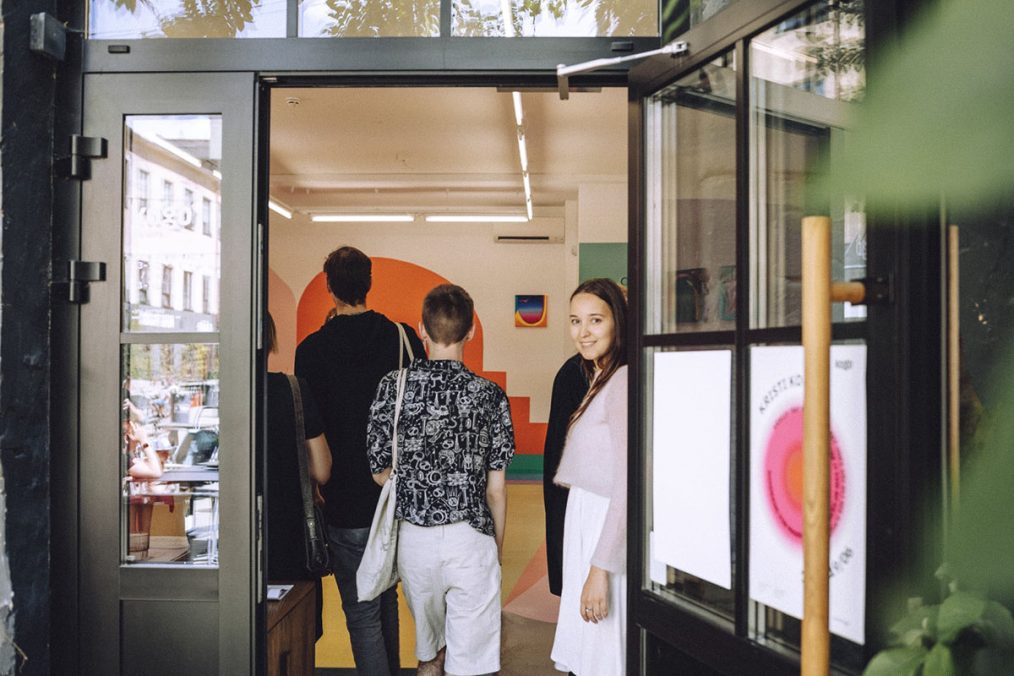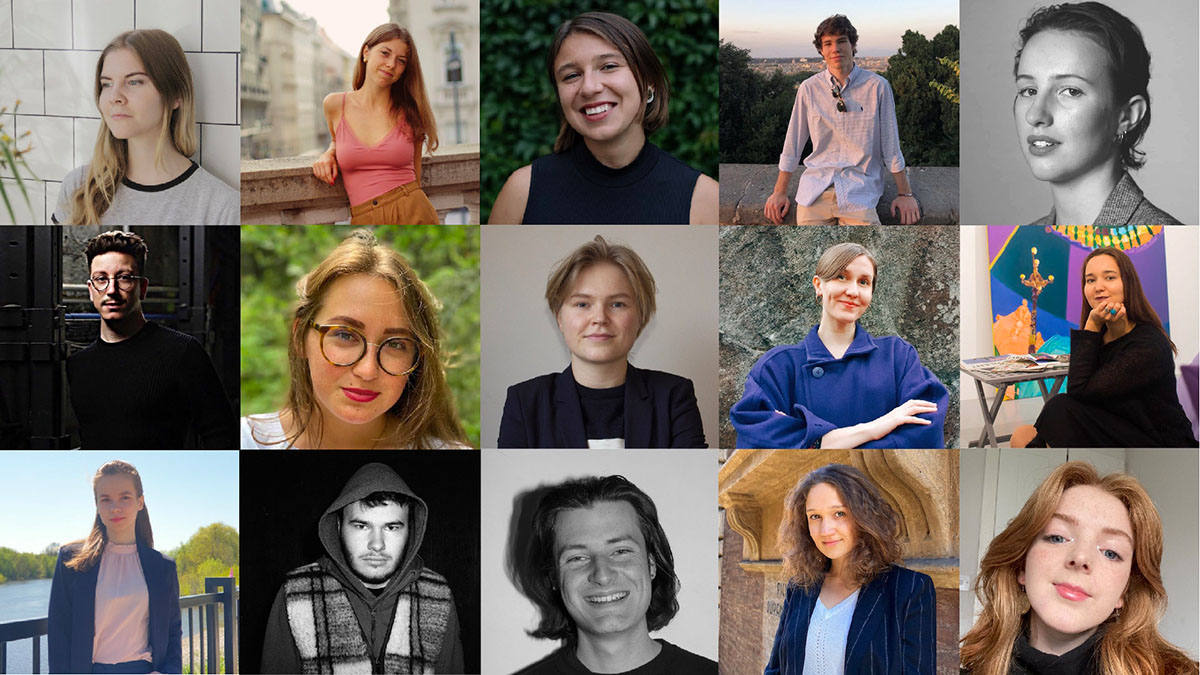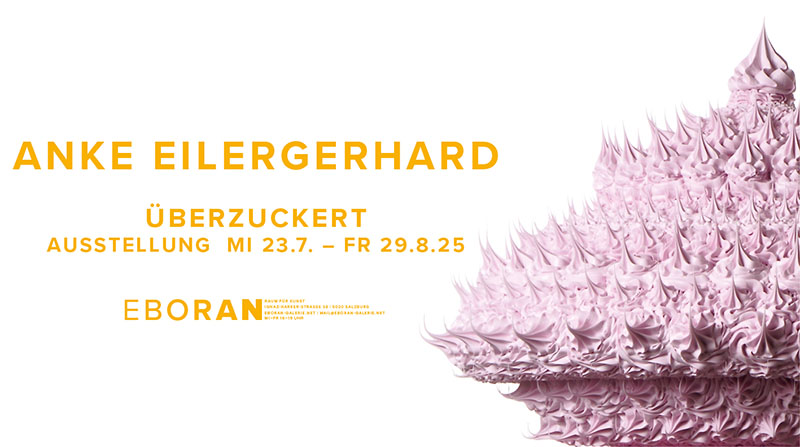
A how-to guide on navigating the art world: interview with Anastasia Lemberg-Lvova about De Structura.
With 10 years of experience in the European Youth Parliament (EYP), Anastasia Lemberg-Lvova is not only a painter but also an activist making way for change in the field of arts and culture. Anastasia’s curiosity for the arts started early, and her childhood passion led her to doing a degree in Fine Arts, with a minor in international relations. Upon graduation, she started to get acquainted with the structures of the sector that feel outdated and saw that the barriers of entry for young artists are needlessly high. From this realisation, Anastasia decided to combine her passion for art and her experience in civic engagement to found the non-profit organisation De Structura. It supports young art professionals in navigating the existing structures of the art world, while simultaneously building new more modern systems. To do this De Structura will gather 150 young art professionals in the fields of visual and performing arts. They will join the project from different countries of the European continent to communicate with experts and their peers in order to realise 20 cross-border projects and discover the institutional politics of art. Throughout this project the team of De Structura will document the experiences of young artists and art professionals. It will also propagate the results to relevant stakeholders, like educational institutions and decision makers.
How did you come up with the idea of De Structura?
When I started interning and working in the sector, it quickly became apparent structural issues that could easily be addressed were being ignored. Contrary to my experience in EYP, where motivation is high, people are interested in trying new things, willing to collaborate and help each other improve, in the art sector much of what I was experiencing was the opposite. The hierarchies I faced were overwhelming, and there was little room to express my own opinion or make changes to existing processes. Even when I was working on my own exhibitions, it always felt that the responsibility was always entirely on my shoulders. I planned, funded and created the art. While I had some help from friends and interns, it felt that getting to be an artist at all should feel like a privilege and honour, leaving other stakeholders like gallerists and funding organisations responsibility free. Being an artist seemed less about creativity and more about climbing the social ladder.
When did this understanding of institutional problems transform into the idea of the De Structura project?
The idea for De Structura started back in 2018 but really took shape in 2020. We started to form a team and contacted the first partners in the fall of 2020, and in March 2021 I founded the non-profit officially. By today, we are a team of 15 young artists and art professionals supported by 50 partners and even more additional stakeholders, for example in educational institutions and decision makers in Europe. The desire to change the art sector within this group is palpable. The pandemic has only amplified this desire, as it has shown that when push comes to shove, art and culture is the last priority for governments because of its perceived low economic worth. De Structura wants innovation in the systems that the art world is built upon. We will look into these systems in collaboration with young artists and art professionals, and suggest ways to make them more accessible for all of us. We will work with our more than 50 partners across Europe to bring in additional knowledge and support in this process.
Where does the name De Structura come from?
The name reflects the different elements tackled by the organisation. Structura is what we’re trying to explore – the structures, systems and models that govern the art world. We want to understand and where needed to rethink them. The “De” in De Structura should be understood both as the Latin word meaning about and the prefix meaning away. This double meaning embodies our intention to be both a pool of knowledge (like a modern multimedia treatise) on the art world as much as a platform to de/re-structure some of its systems. The inspiration for the name comes from the artist, architect, poet and philosopher Leon Battista Alberti, who revolutionised the history of art with his theories on perspective On Painting – De Pictura (1435). Inspired by the order and beauty inherent in nature, his groundbreaking world set out the principles of distance, dimension and proportion, and instructed the painter on how to use the rules of composition, representation, light and colour to create work that is graceful and pleasing to the eye. This all resulted in a concise stipulation on the moral and artistic prerequisites of the successful painter. These prerequisites of old have expired, yet new ones have not yet emerged. By focusing on the principles of equal access, inclusive work environment and merit based opportunity, De Structura will instruct young art professionals on how to use their enthusiasm, ambition, talent and perseverance to create an art world that is graceful and fulfilling to be in. Together with young artists and art professionals, we will describe the new professional, empathic and inclusive structures needed for this.
Who is the ideal potential participant for De Structura?
In total we are looking for 100 young artists and art professionals. We look for people between the ages of 21 and 30 in the field of visual and performing arts, who through their diverse skills and effort would be motivated to contribute to the betterment of Europe as a habitat for artistic practice. Collaboration between borders is central to our activities, as we believe that diversity of opinion and experience will ultimately result in the best outcomes for young people. We look for people that want to challenge the current systems, as well as rethink the preconceived notions of the role of artists in society. Perhaps collaboration and teamwork are the new authorship and autonomy?

You were involved in the work of the European Youth Parliament (EYP) for about 10 years. To what extent does it influence your project?
My experience in EYP is a big influence on the project. For one, We are organising a forum as a mid-point to convene with all of our participants – sessions and fora are the flagship events of EYP. Secondly, the format of the research participants will be conducting is based on committee work of EYP. Through this De Structura brings civic engagement to the arts in an organised and nuanced way. Although there is also an important difference – while EYP is more or less educational only, De Structura aims to bring about tangible results in the real world. During the second part of the forum participants will be designing and realising collaborative projects.
Can you share some more details about the forum?
During the first half of the forum, participants will share the results of their research with the other groups and participants. This will be a moment to learn from each other, exchange ideas, pose new questions and propose potential solutions. In the second half of the forum, the participants will split into new groups of 3-6 people, according to their interests. We want these groups to be mixed in terms of profile, so artists, curators, art managers can come together and each contribute their relevant skills towards a common topic of interest, that they will further research and make work about with the help of our experts and partners. For example, you’d have a group of four – a curator from France, an artist from Poland and Spain, and an art manager from Germany. Say they are all interested in AI as a means of creative expression. They will get together and start coming up with an actual project plan including fundraising, communication, production. So the last 4 days of the forum will be about practical output. The results of the forum will be carefully documented and then publicly disseminated with educational institutions and decision makers alike. It is here that our work for creating impact starts.
Let’s talk a little bit more about the context surrounding the project. What frustrates you most about the current art world status quo?
The art world is bizarre in its essence. The individuals within it are often the most progressive, open minded, collaborative and empathic people I’ve met. Yet the structures that govern the sector are rigid, demotivating and favour hierarchy instead of teamwork. For me, this structure is not only limiting but it is corruptive of the individuals that feel suffocated within it. And while many initiatives seem to be innovative, supportive of collaboration and questioning the status quos, they generate little impact. The sector struggles to materialise its own critique of society and too often disregards the innovative approaches suggested by newcomers. In its quest for openness at large, the art and culture sector has become isolated, closed and protective within.
Do you have an idea why this is the case in such an innovative field?
To be an artist is inevitably a precarious endeavour, and the few places of security are often found within the institutions that govern the sector. In museums, educational institutions, funding organisations. These are places where the rules of the game are set, yet the people who set the rules are incentivised to keep the structures that got them that secure position in the first place. With all the good intentions one can have, those in positions of power rarely realise that perhaps they themselves are part of the problem. And so it begins, the age old crusade of young people fighting for their position, then finally getting it and becoming gatekeepers themselves. We don’t see this as sustainable, it definitely is not inclusive and in line with the values of our generation of artists and art professionals. In October 2021 I was at an event organised by the Charlemagne Award, where the 2020 award recipient Klaus Iohannis, the current president of Romania, was speaking. During the Q&A, I asked him how to tackle this dynamic. He cheerfully confirmed that this is the natural process of life – young people come and want change, need to fight for that change and solidify their grip on the systems like the generations before. But now, in the aftermath of the ecological, technological and political crisis we need to come up with more sustainable ways of organising the art and culture sector. If we don’t, it will only be to our own detriment. The scepticism that young artists and art professionals have of these institutions needs to be turned into action.
If we think about the particular issues in the art world right now which institutional changes are the most needed in Europe?
We don’t have all the answers. This is one of the big reasons why I started De Structura, to find answers to these types of questions. We are speculating to find areas of improvement within three realms, educational, economic and political. The gap between what formal education is able to provide and the skills needed for professional practice is alarming. As an organisation, we want to bridge that gap on both ends, by helping artists as well as schools. On an economic level, artists and art professionals need to start facing reality. In a capitalist society, money speaks. Public funding for the arts needs to increase, but we can’t be gambling that society as a whole will always elect the politicians needed to push that funding through. The arts needs to become more self-reliant, and use its creativity to come up with economic models to support itself. I suspect these are the areas where we will focus our efforts as an organisation, but I don’t want to skip the steps we are undertaking within the project. Above all, though, we want to support the artists and art professionals within all of this. It’s not acceptable that universities tell their students not to worry about their future and focus solely on making, when students ask their professors how they can survive after graduation. Artists who have part-time jobs seem to have the need to hide that fact from their peers, as the pressure to maintain that autonomous artist image seems to have resulted in a reality where the perception of their identity is more important than the reality they experience. Young artists and art professionals will bring about the change needed, the question will be whether existing institutions want to be supportive of these efforts or whether they will only maintain and uphold the structures from which these issues stem.
Do you know some examples of significant institutional change due to some ambitious projects like De Structura?
Change is never about one person or one institution, change comes through movements, through collective action and through bringing the underlying causes of our common struggle to the surface. I strongly believe in the format of a platform, that De Structura will be for young artists and art professionals. As a platform, our efforts are organised within a limited group, yet the knowledge, skills, connections and motivation that the individuals within this limited group can disperse, will reach the globe. De Structura will devise a targeted strategy for advocacy, but the bigger contribution we will have is through all of the invisible and untraceable work that we spark as a platform. In that sense, we can be the catalyst where change can start, but the challenges we face are far too enormous for us to tackle them ourselves alone. It is about changing how people think and perceive what is fair. Like how in the private sector, the 4-day work week is starting to become the new normal. Or how the pandemic has reshuffled our relationship with the office or work in general. What do we value really? And how can we act upon these values? When during lockdowns theatres and museums are the first to be closed and last to be opened, are art and culture really the prerequisites to modern society we claim they are? I say they are, and they need to be made more accessible.
Open call. The call for participants is open for the 2022 edition. In our two-year, cross-border collaborative project which – through research, discourse and creative work – will unearth and challenge the dominant paradigms and structures of European art worlds. More information: https://destructura.com/opencall/ Application form: https://destructura.typeform.com/opencall Deadline: 28th of February 23:59 CET
De Structura – www.destructura.com





